GALLUP NEWS SERVICE
PRINCETON, NJ -- There are many ways to measure Americans' belief in God, and in part the conclusions one reaches on this topic depend on how that belief is defined in the question wording. If Americans are simply asked if they believe in God or a universal spirit, more than 90% will say yes. If Americans are given more finely-tuned response categories, it becomes obvious that a somewhat smaller percentage of Americans, although still the substantial majority, are absolutely convinced that God exists.
In several recent Gallup Polls, adult Americans have been asked about God using this more complex format involving five alternative beliefs:
Which comes closest to describing you -- [ROTATED: you are convinced that God exists, you think God probably exists, but you have a little doubt, you think God probably exists, but you have a lot of doubt, you think God probably does not exist, but you are not sure, (or) you are convinced that God does not exist]?
|
Convinced God exists |
Probably exists, have a little doubt |
Probably exists, have a lot of doubt |
Probably does not exist, but not sure |
Convinced God does not exist |
No |
|
|
% |
% |
% |
% |
% |
% |
|
|
2006 May 8-11 |
73 |
14 |
5 |
4 |
3 |
2 |
|
|
|
|
|
|
|
|
|
2005 Nov 17-20 |
78 |
12 |
4 |
4 |
1 |
1 |
|
2005 Oct 24-26 |
80 |
8 |
3 |
4 |
3 |
2 |
The latest responses to this question, obtained in a May Gallup Poll, lead to several conclusions:
- Seventy-three percent of Americans are classic true believers, convinced that God exists beyond a doubt.
- Eighty-seven percent of Americans are basic believers in the existence of God, saying either that they are convinced that God exists or that God probably exists and they have only a little doubt that this is the case.
- A slightly larger group of 92% of Americans can be classified in a group that tilts toward the existence of God, stating that at the least they think God probably exists, even though some have a lot of doubt about it.
- Only 3% of Americans can be considered to be hard-core atheists, convinced that God does not exist.
- Another 4% are agnostics of a sort, leaning toward a belief that God does not exist, but not sure that this is the case beyond a doubt.
Of interest is the distribution of these beliefs across subgroups in the U.S. population. Just who is it that is most likely to believe in God, and who is least likely to believe in God?
For the purposes of this analysis, we will look at the group of basic believers -- those who are certain, with no doubts, there is a God, and those who have a few doubts but believe there is probably a God. To increase the reliability of the analysis, the figures discussed below are based on an aggregate of more than 2,800 interviews conducted in the October 2005, November 2005, and May 2006 polls.
Age
Most measures of religiosity are lower among young people than older people. We know that younger people are less likely to report attending church, less likely to say that religion is important in their daily lives, and more likely to report having no religion at all than are those who are older.
But these data do not reflect this age-related correlation with belief in God. Younger Americans appear just as likely as those who are older to report being certain or almost certain that God exists.
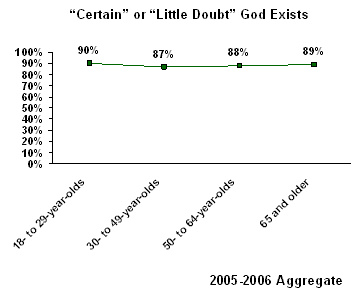
In other words, the less overtly religious status of young Americans does not appear to be reflective of the lack of underlying beliefs in the existence of God.
Socioeconomic Status
An inverse relationship exists between levels of education and income and belief in God. Generally speaking, Americans who have attained higher levels of education and who have higher household incomes are less likely to be certain that God exists than those who are on the other end of the socioeconomic spectrum:
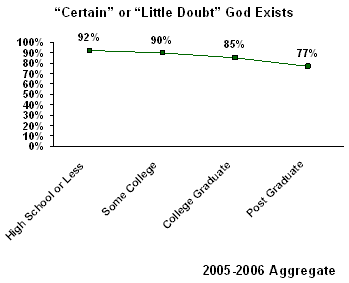
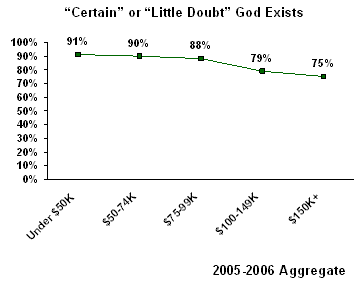
Only about three-quarters of Americans with post-graduate educations or with incomes above $150,000 a year are certain that God exists or believe that God probably exists and have only a little doubt. That compares with more than 9 out of 10 of those with high school educations or less, and about 9 out of 10 of those making less than $50,000 a year in family income.
Some of this may reflect the generally more skeptical nature that often comes with more formal education. Those who are college graduates may have been socialized to be more cautious about agreeing with any statement of fact. There are also many theories about the functions of religion that may come into play here; those who have fewer material possessions or who are more oppressed in this life may be more likely to depend on the belief in a God and the potential for a blissful life after death as a coping mechanism for dealing with their current life circumstances.
Gender
Women are more religious than men on many measures, including self-reported importance of religion in one's daily life and active church attendance and church participation. It is not surprising, therefore, that we find a modest gender difference in terms of belief in God. Ninety-one percent of women are in the "basic believers" category, compared to 85% of men.
Region
Perhaps not surprisingly, there is slightly less certainty about the existence of God on both coasts of the United States.
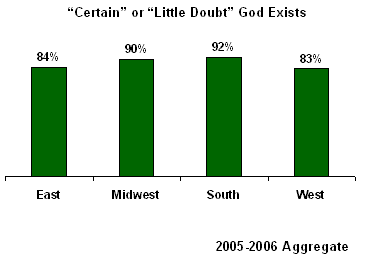
Nine out of 10 residents of the South and Midwest believe in God, compared to 83% and 84% of those living in the West and the East, respectively.
Politics
By almost all measures, Republicans are more religious on average than are independents or Democrats. Republicans are more likely to attend church regularly and are more likely to identify with a specific religious group. Only slight differences exist in belief in God, however.
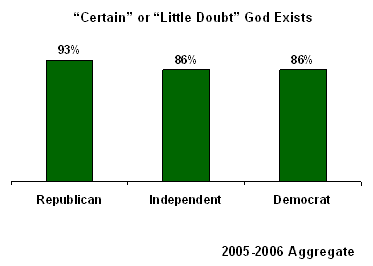
Survey Methods
These results are based on telephone interviews with randomly selected national samples of approximately 1,000 adults, aged 18 and older, conducted at three points in time: Oct. 24-26, 2005, Nov. 17-20, 2005, and May 8-11, 2006. For results based on any one of these samples, one can say with 95% confidence that the maximum error attributable to sampling and other random effects is ±3 percentage points. For analyses involving the aggregate of all three polls, the maximum error attributable to sampling and other random effects is ±2 percentage points. In addition to sampling error, question wording and practical difficulties in conducting surveys can introduce error or bias into the findings of public opinion polls.